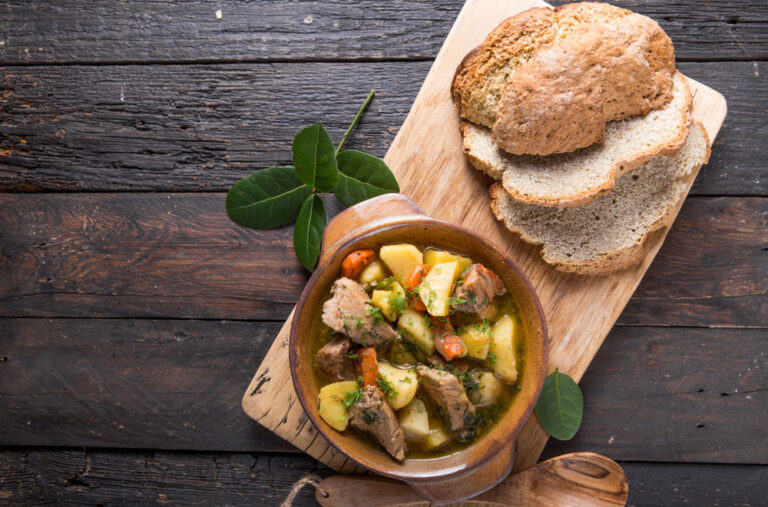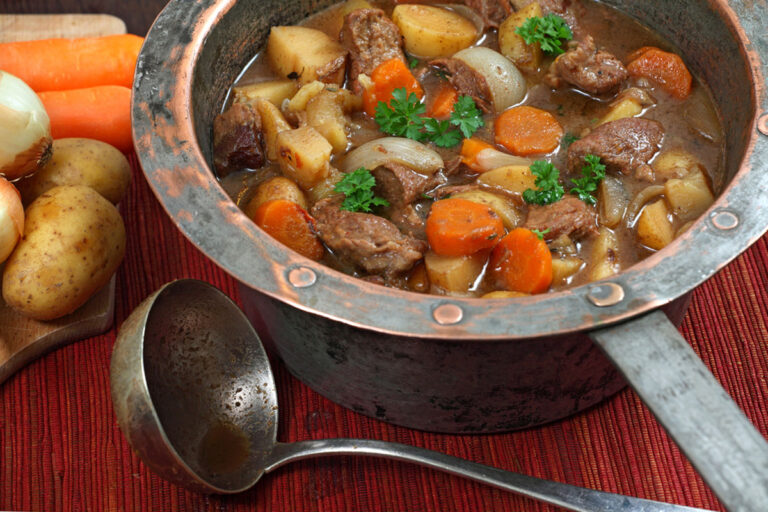Irish Whiskey
With its rich history and superb workmanship, Irish whiskey has won a well-deserved place in the hearts of whiskey connoisseurs all over the world. Irish whiskey symbolizes the essence of Irish culture and heritage since it is distilled using traditional methods that have been refined over centuries.
The triple distillation method is one of Irish whiskey’s unique features. Unlike other whiskey styles, which are normally distilled twice, Irish whiskey is distilled three times, yielding a smoother and more refined spirit. This thorough distillation process removes contaminants, allowing the natural flavors of the whiskey to shine through.
The maturing process is another important component that contributes to the distinct flavor of Irish whiskey. The whiskey is aged in oak barrels after distillation, where it matures and acquires its characteristic flavor over time. These barrels, which were previously used for bourbon or sherry, impart flavors and smells that compliment the natural attributes of the whiskey. The maturing process also gives Irish whiskey smoothness and complexity, making it a joy to drink.
The flavor profile of Irish whiskey is noted for its balance and variety. While each type has its own distinct flavor, Irish whiskey typically has overtones of honey, vanilla, fruit, and mild spices. Because of the smoothness of the spirit, these flavors blend nicely, giving a lovely tasting experience.
Brands like Jameson, Bushmills, and Tullamore Dew have become synonymous with Irish whiskey and have played an important part in its globalization. Jameson, founded in 1780, is the most well-known Irish whiskey brand, famed for its smooth and approachable flavor. Bushmills, on the other hand, has a rich history and uses traditional distillation procedures that date back to 1608. Tullamore Dew delivers a distinct and complex flavor profile with its triple-distilled blend of grain, malt, and pot still whiskeys.
Several reasons have contributed to the increased popularity of Irish whiskey. For starters, the industry’s dedication to quality and tradition has ensured that Irish whiskey retains its status as a premium beverage. Furthermore, the growing interest in craft spirits and artisanal items has led to a greater appreciation for the craftsmanship involved in the manufacturing of Irish whiskey.
Furthermore, the smooth and approachable character of Irish whiskey has widened its appeal beyond whiskey experts, drawing beginners to the category. It’s a fantastic introduction to the world of whiskey for people who prefer a more delicate and subtle flavor profile.
Irish whiskey has seen a renaissance in recent years, with new distilleries and novel expressions joining the market. This rebirth has resulted in a wide variety of flavors and styles, allowing whiskey fans to explore and discover new aspects of Irish whiskey’s legacy.
Irish whiskey is a great sensory experience whether sipped neat, on the rocks, or in a classic cocktail like an Old Fashioned or an Irish Coffee. Its smoothness, complexity, and distinct flavor profile have made it a popular export and true ambassador for Irish culture and workmanship. With every sip, Irish whiskey transports you to the rolling green landscapes and warm hospitality of the Emerald Isle.
Guinness
Few beverages in Ireland have gained the level of recognition and cultural significance that Guinness stout has. Guinness has been brewed by the Guinness brewery in Dublin since 1759 and has become an iconic emblem of Ireland as well as a popular beer around the world.
Guinness is distinguished by various features that make it easily recognizable. The deep, dark color of the beer, nearly black in appearance, is due to roasted barley. When paired with a creamy, thick head, this results in a visually pleasing pint that is immediately associated with Guinness.
However, it is not just the sight of Guinness that draws people in; it is the flavor and texture that actually distinguishes it. The beer is deep and malty, with hints of coffee, dark chocolate, and caramel richness. A mild bitterness balances these diverse notes, giving a well-rounded taste experience.
Guinness’ silky smooth smoothness is one among its most noticeable characteristics. This is accomplished by a novel brewing technique known as the “nitrogenation” or “widget” system. In the can or keg, a little plastic or metal gadget known as a widget is put. When the beer is poured, the widget emits nitrogen gas, which creates the small bubbles that give Guinness its famously creamy and velvety mouthfeel.
Guinness has not only won the hearts of beer drinkers, but it has also been ingrained in Irish society. A pint of Guinness is almost a rite of passage for locals and visitors alike in Dublin, where the brewery is located. Traditional pubs, with their comfortable ambiance and welcoming attitude, are the ideal setting for relishing this Irish treasure.
The Guinness Storehouse is a prominent tourist site in Dublin that teaches tourists about the history and brewing process of Guinness. They can see firsthand the craftsmanship and care that goes into each pint.
Guinness has a devoted global following outside of Ireland’s borders. Guinness tastes the same in Dublin, London, New York, and Tokyo because of the brand’s devotion to quality and consistency. It has become a standard in pubs and clubs all around the world, with enthusiasts eager to have a taste of Ireland no matter where they are.
Guinness has also broadened its products beyond the standard stout in recent years. Guinness Foreign Extra Stout, Guinness Nitro IPA, and Guinness Draught have brought new flavors and styles, attracting a wider range of beer drinkers.
Because of its ongoing appeal and cultural significance, Guinness has become a true ambassador for Ireland. It embodies the hospitality, conviviality, and rich traditions of Irish pub culture. Guinness has become linked with camaraderie and good times, whether toasting with friends or celebrating St. Patrick’s Day.
Finally, Guinness is more than just a drink. It is an Irish cultural icon and a testimony to the country’s brewing heritage. Its distinct flavor, velvety texture, and distinctive appearance have made it a beloved Irish drink export that continues to wow beer enthusiasts worldwide. So, wherever you are, raise a glass and share in the centuries-old tradition of drinking a pint of Guinness. Sláinte!
Irish Beef
Ireland’s reputation for producing outstanding beef is a result of its rich green pastures, good climate, and farmers’ dedication. The geographical advantages of the country, such as its ample rainfall and temperate temperatures, produce ideal circumstances for cattle rearing, resulting in high-quality Irish beef that is sought after around the world.
The diet of the animals is one of the primary factors leading to the exceptional flavour and tenderness of Irish beef. Irish cattle are predominantly grass-fed, grazing on the country’s nutrient-rich meadows. This grass-fed diet gives the beef a distinct flavor profile that is distinguished by its natural sweetness and deep depth of flavor. The grazing method also permits the cattle to build a healthy, robust muscle structure, which results in tender, delicious meat.
Aside from the beef’s quality, Irish beef has earned a great reputation in worldwide markets due to the country’s commitment to animal welfare and sustainable agricultural practices. Irish farmers prioritize the well-being of their livestock by providing them with plenty of space to roam, clean water, and a stress-free environment. This emphasis on animal care not only aligns with ethical standards, but also adds to higher meat quality.
Sustainable farming practices are also essential in the production of Irish beef. Farmers in Ireland focus environmentally friendly practices such as rotational grazing and careful land management to maintain pasture health and reduce farming’s environmental impact. This commitment to sustainability assures the industry’s long-term success while also protecting the natural beauty of the Irish countryside.
The traceability of Irish beef is one of its distinguishing features. Every stage of the manufacturing process is thoroughly controlled and documented from farm to fork, providing consumers with confidence of the beef’s quality, safety, and origin. This traceability is enabled by strong quality assurance procedures and stringent inspections, which ensure that Irish beef satisfies the highest standards and laws.
Irish beef’s reputation has not gone unnoticed on the world culinary scene. Chefs and culinary fans all around the world seek for Irish beef for its remarkable flavor and adaptability in a variety of dishes. The rich flavor and suppleness of the meat make it ideal for grilling, roasting, and braising, allowing chefs to highlight its natural attributes in a variety of culinary creations.
Irish beef is highly prized in high-end restaurants and marketplaces, where discerning consumers respect its excellent quality and adherence to ethical and sustainable farming practices. Its appeal is being pushed further by the global trend of eating locally sourced, high-quality ingredients.
Ireland’s beef business is thriving, with continual attempts to preserve and improve its image. Irish farmers work hard to keep their beef at the forefront of the global market, through genetic enhancement initiatives and novel farming techniques. Irish beef’s place as a sought-after commodity in the international culinary landscape has been cemented by the industry’s commitment to quality, animal welfare, sustainability, and traceability.
Finally, Ireland’s vast green pastures, suitable climate, strong animal welfare requirements, and sustainable farming practices all help to produce high-quality Irish beef. Its remarkable flavor, softness, and traceability make it a sought-after export on the global culinary stage. Irish beef continues to enchant the palates of consumers globally as a result of the country’s commitment to excellence and maintains its standing as a quality hallmark in the beef sector.
Kerrygold Butter
Kerrygold Butter has become a well-known name in the world of premium dairy goods. Kerrygold Butter has developed a dedicated following and acclaim for its great taste and texture due to its commitment to quality and the use of Ireland’s natural resources.
Kerrygold Butter’s source of milk from grass-fed cows is one of its distinguishing features. The lush, luscious meadows of Ireland provide an ideal setting for cows to feed on nutrient-rich grass all year. This grass-based diet adds to higher milk flavor and quality, which improves the taste and richness of Kerrygold butter.
Kerrygold butter is made using milk that has been carefully selected and churned using traditional procedures. The cream is separated from the milk and churned until it solidifies into butter during the butter-making process. This ancient method preserves the butter’s inherent flavors and particular features.
As a result, the butter has a beautiful, golden color, which can be linked to the high beta-carotene content of the grass fed to the cows. This brilliant color enhances the visual attractiveness of foods and pastries, making them even more appealing.
Another feature that distinguishes Kerrygold Butter is its creamy smoothness. Its smooth and velvety texture allows it to spread easily over bread or melt wonderfully over warm meals. The meticulous craftsmanship and attention to detail in the manufacturing process ensure a consistently high-quality product that retains its rich texture over a wide range of applications.
Kerrygold butter’s exceptional flavor has made it a kitchen staple around the world. Its well-balanced flavor profile creates a delicate balance of creamy sweetness and gentle salinity, complementing the flavor of a variety of culinary creations. Kerrygold Butter lifts ordinary meals to new heights, adding a delicious richness and depth of flavor whether used in baking, cooking, or simply eaten on its own.
Kerrygold butter is a favorite among both home cooks and professional chefs due to its versatility and quality. It is well-known in the culinary world for its capacity to improve the flavor and texture of baked goods including flaky croissants, tender cakes, and buttery pastries. Furthermore, due to its silky consistency, it is an excellent ingredient for sauces, spreads, and even as a finishing touch on grilled meats and vegetables.
Kerrygold Butter’s reputation goes beyond its native Ireland. Its devotion to quality and natural ingredients has resonated with consumers all around the world, resulting in its availability in a wide range of international markets. Because of this, people from all walks of life can now enjoy the rich flavors and high quality of Kerrygold butter.
Finally, Kerrygold Butter has established itself as a premium brand connected with dairy quality. Its milk is sourced from grass-fed cows, traditional production methods are used, and attention to detail is paid throughout the process, all of which contribute to its outstanding taste, rich texture, and vivid color. Kerrygold Butter improves recipes and elevates the culinary experience, making it a favorite and trusted ingredient among chefs, bakers, and food enthusiasts worldwide.

Irish Smoked Salmon
The excellent flavor and sumptuous texture of Irish smoked salmon have earned it a well-deserved reputation as a delicacy. This gourmet pleasure, sourced from the beautiful waters surrounding Ireland, exemplifies the country’s devotion to quality and mastery in traditional smoking processes.
Irish smoked salmon begins with carefully selected, high-quality salmon, most typically Atlantic salmon. These fish thrive in the clear, cold seas off the coast of Ireland, where they develop a natural richness and fatty consistency that lends themselves nicely to smoking.
The curing process is the first step in making Irish smoked salmon. The salmon is meticulously covered with a combination of salt, sugar, and other seasonings to draw out moisture, preserve the fish, and enhance its flavor. This precise and skillful curing technique produces a delicate balance of flavors and textures in the final product.
After curing, the salmon is gently smoked utilizing methods such as cold smoking or hot smoking. Cold smoking is the process of exposing fish to cool smoke for an extended period of time to create a subtle, nuanced smoky taste without entirely frying the fish. In contrast, hot smoking entails exposing the salmon to higher temperatures, resulting in a more intense smoky flavor and a slightly tougher texture.
The smoking process is an art form in and of itself, with experienced smokers carefully managing temperature, smoke levels, and timing to create the appropriate flavor and texture.
Various woods, such as oak or beech, can be utilized to add unique characteristics and improve the overall flavor profile.
These painstaking techniques result in Irish smoked salmon with a delicate flavor and velvety texture. The smokey overtones complement the salmon’s creamy, buttery flavor, producing a lovely balance of flavors. The texture is velvety and silky, with a melt-in-your-mouth feel that seafood lovers adore.
Irish smoked salmon has become a worldwide favorite among fish enthusiasts, making it a profitable export for Ireland. Its high quality and reputation for excellence have made it a popular ingredient in gourmet restaurants, upmarket markets, and specialized food stores all over the world.
Irish smoked salmon’s adaptability lends itself to a wide range of culinary uses. It’s best served simply, on a bed of greens or artisanal bread, with a touch of lemon or a dollop of crème fraîche. Its delicate flavor complements other components such as cream cheese, capers, dill, or thinly sliced red onions.
Irish smoked salmon provides a touch of elegance and sophistication to a variety of cuisines, whether as an appetizer or as a stand-alone dish. It can be used in pasta meals, quiches, omelets, or as a pizza or bruschetta topping. Its flexibility extends to the world of sandwiches, where it elevates conventional combinations.
Irish smoked salmon production not only demonstrates Ireland’s culinary expertise, but also the country’s commitment to sustainable fishing practices and the preservation of its natural resources. The careful sourcing of salmon from well-managed fisheries assures the industry’s survival and the protection of the marine ecology.
Finally, Irish smoked salmon is a true culinary treasure, praised for its exquisite flavor, velvety texture, and the skill that goes into its creation. This exquisite feast represents the richness and purity of Irish seafood, from the pristine waters of Ireland to dining tables throughout the world. Irish smoked salmon provides a delicious and unforgettable gastronomic experience whether enjoyed on its own, as part of a dish, or as an elegant complement to a gourmet creation.
Irish Soda Bread
Irish soda bread, a traditional component of Irish cuisine, has crossed borders and garnered worldwide renown. This rustic bread, noted for its simplicity and distinct features, has become a popular addition to many tables far beyond Ireland’s borders.
The charm of Irish soda bread rests in its simple ingredients and execution. The main ingredients that go into making this delicious bread are flour, buttermilk, baking soda, and salt. The use of baking soda as a leavening agent rather than yeast gives the bread its particular texture and flavor.
Irish soda bread is distinguished from other forms of bread by its crumbly texture. When the ingredients are combined and baked, they form a dense yet soft crumb that breaks apart effortlessly. The reaction between the acidic buttermilk and the alkaline baking soda produces carbon dioxide bubbles, which give the bread its characteristic rise and crumb structure.
In terms of flavor, Irish soda bread has a delectable balance of tastes. The acidic undertones from the buttermilk give a nice contrast to the bread’s gentle sweetness. The subtle tang provides depth to the overall flavor profile, making the bread a suitable accompaniment to a variety of foods.
One of Irish soda bread’s best qualities is its adaptability. It goes well with substantial soups and stews because the crumbly texture absorbs the flavors of the accompanying food, resulting in a fulfilling and comforting dinner. Its somewhat acidic flavor matches the richness of traditional Irish breakfasts, when it is frequently consumed alongside bacon, sausages, eggs, and black pudding.
While traditional Irish soda bread is a circular loaf with a cross on top, variations in shape and ingredients have arisen over time. Some varieties include extra ingredients like raisins, currants, or even cheese, which provide a hint of sweetness or savory richness to the bread. The classic, basic variety, on the other hand, is the most iconic representation of Irish soda bread.
Irish soda bread is deeply ingrained in Irish culture. For ages, it has been a mainstay in Irish households, providing sustenance and food to families. Because it involves only a few basic ingredients and can be prepared quickly, the bread is a sensible alternative for households with low finances.
Outside of Ireland, the appeal of Irish soda bread can be ascribed to its rustic charm and the growing love for traditional, handcrafted meals. Its simple recipe and distinct qualities make it an appealing alternative for home bakers and those looking for a real taste of Irish food.
Irish soda bread has grown in popularity as part of the St. Patrick’s Day celebration in recent years. It has become a symbol of Irish heritage, and it is frequently served alongside other traditional Irish meals throughout the holiday season.
Finally, the appeal of Irish soda bread outside of Ireland can be linked to its basic yet attractive qualities. Its characteristic crumbly texture, somewhat tangy flavor, and adaptability make it a popular ingredient in dishes all around the world. Irish soda bread continues to grab the hearts and taste buds of those who love its rustic charm and authentic taste, whether served with soups, stews, or a traditional Irish breakfast. (try our Irish soda bread recipe)
Conclusion
Food and drink exports from Ireland have played an important part in exhibiting the country’s culinary skills to the rest of the world. These goods have captivated taste buds and contributed to Ireland’s image as a food and drink destination, from the smoothness of Irish whiskey to the rich tastes of Guinness and the quality of Irish beef. Whether it’s a pint of Guinness, a slice of soda bread, or the richness of Kerrygold butter, Ireland’s culinary offerings will leave you with a lasting impression and a need for more.



